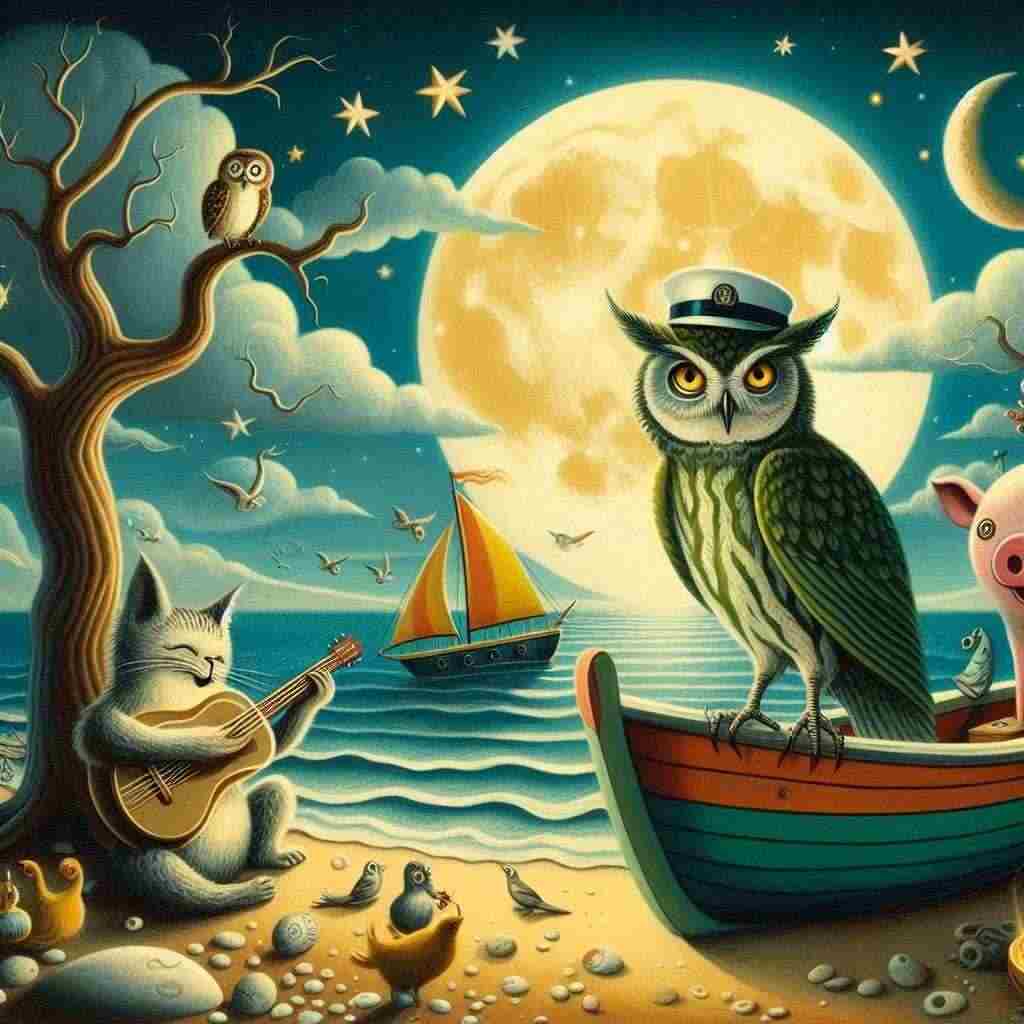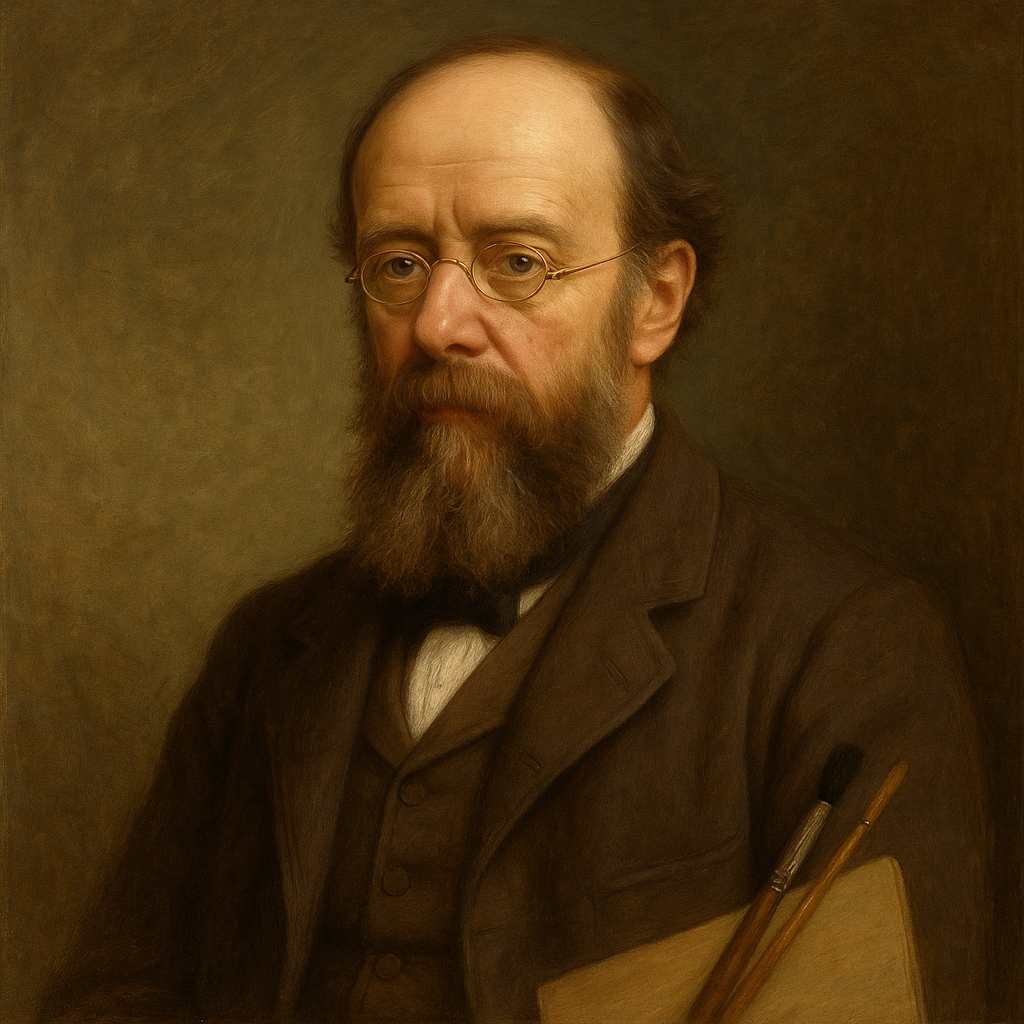The Owl and the Pussy-cat
Edward Lear
1812 to 1888

Want to track your favorites? Reopen or create a unique username. No personal details are required!
I
The Owl and the Pussy-cat went to sea
In a beautiful pea-green boat,
They took some honey, and plenty of money,
Wrapped up in a five-pound note.
The Owl looked up to the stars above,
And sang to a small guitar,
"O lovely Pussy! O Pussy, my love,
What a beautiful Pussy you are,
You are,
You are!
What a beautiful Pussy you are!"
II
Pussy said to the Owl, "You elegant fowl!
How charmingly sweet you sing!
O let us be married! too long we have tarried:
But what shall we do for a ring?"
They sailed away, for a year and a day,
To the land where the Bong-Tree grows
And there in a wood a Piggy-wig stood
With a ring at the end of his nose,
His nose,
His nose,
With a ring at the end of his nose.
III
"Dear Pig, are you willing to sell for one shilling
Your ring?" Said the Piggy, "I will."
So they took it away, and were married next day
By the Turkey who lives on the hill.
They dined on mince, and slices of quince,
Which they ate with a runcible spoon;
And hand in hand, on the edge of the sand,
They danced by the light of the moon,
The moon,
The moon,
They danced by the light of the moon.
Edward Lear's The Owl and the Pussy-cat
Edward Lear's "The Owl and the Pussy-Cat" is a whimsical and enchanting nonsense poem that has captivated readers since its publication in 1871. Through its playful language, imaginative imagery, and unconventional narrative, the poem explores themes of love, adventure, and the blurring of boundaries between the rational and the absurd.
The poem's structure consists of three stanzas, each narrating a distinct phase of the protagonists' journey. This tripartite structure mirrors the classic storytelling format of beginning, middle, and end, providing a sense of progression and closure to the fantastical tale. The use of simple, repetitive rhyme schemes and metrical patterns contributes to the poem's musicality and makes it accessible to readers of all ages.
At its core, "The Owl and the Pussy-Cat" is a love story that defies conventional expectations. The unlikely pairing of an owl and a cat immediately establishes the poem's departure from reality and invites readers to suspend their disbelief. This interspecies romance challenges societal norms and celebrates the idea that love can transcend boundaries. The characters' decision to elope further emphasizes their rejection of traditional constraints, embodying a spirit of freedom and nonconformity.
The journey motif is central to the poem's narrative and symbolic significance. The owl and the pussy-cat's sea voyage in a "beautiful pea-green boat" represents a departure from the familiar into the unknown. This journey can be interpreted as a metaphor for the adventure of love and partnership, or more broadly, as a representation of life's unpredictable nature. The inclusion of practical elements like honey and money alongside the romantic gesture of the owl's serenade creates a charming balance between the pragmatic and the idealistic aspects of relationships.
Lear's use of nonsense language and imagery is a hallmark of his style and serves multiple purposes within the poem. The "land where the Bong-Tree grows" and the "runcible spoon" are examples of Lear's invented words and concepts that contribute to the poem's whimsical atmosphere. These elements of nonsense not only entertain but also encourage readers to embrace imagination and question the boundaries of language and reality.
The poem's characters, including the Piggy-wig and the Turkey, further populate this fantastical world with anthropomorphized animals. The Piggy-wig's willingness to sell his nose ring for a shilling introduces a touch of commerce into the romantic narrative, perhaps commenting on the practical considerations that often accompany even the most idealistic pursuits. The Turkey's role as the officiator of the wedding ceremony adds a sense of legitimacy to the union while maintaining the poem's playful tone.
The final stanza brings the narrative to a joyful conclusion, with the newlyweds celebrating their union through a feast and a dance. The mention of specific foods like mince and quince adds sensory detail to the scene, while the image of the couple dancing "hand in hand, on the edge of the sand" by moonlight creates a romantic and dreamlike atmosphere. The repetition of "The moon" in the closing lines emphasizes the ethereal quality of the moment and leaves readers with a lasting impression of beauty and harmony.
Throughout the poem, Lear employs various poetic devices to enhance its musical quality and emotional impact. The use of internal rhyme, such as "sea" and "pea" in the first line, contributes to the poem's rhythmic flow. Alliteration, as seen in "Pussy" and "pea-green," adds to the phonetic pleasure of reading the poem aloud. The repetition of phrases, particularly in the final lines of each stanza, creates a refrain-like quality that reinforces key images and emotions.
In conclusion, "The Owl and the Pussy-Cat" stands as a masterpiece of nonsense poetry that continues to delight and intrigue readers. Its enduring appeal lies in its ability to blend the familiar with the fantastic, creating a world where love conquers all and imagination knows no bounds. Through its charming narrative, lyrical language, and underlying themes of unconventional love and adventurous spirit, the poem invites readers to embrace the joy of the absurd and the power of creativity. Lear's work not only entertains but also subtly challenges readers to question societal norms and celebrate the unique and unconventional aspects of life and love.
This text was generated by AI and is for reference only. Learn more
Want to join the discussion? Reopen or create a unique username to comment. No personal details required!



Comments
No comments yet. Be the first to comment!